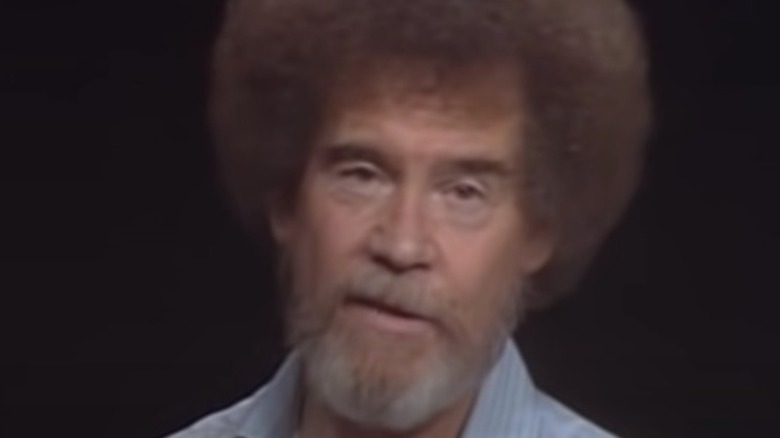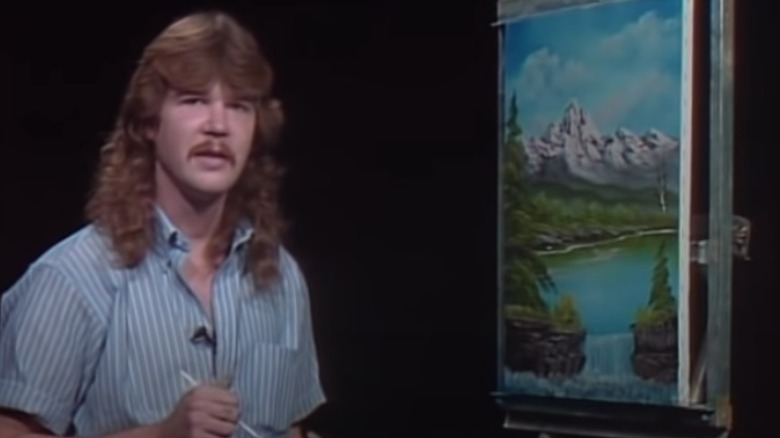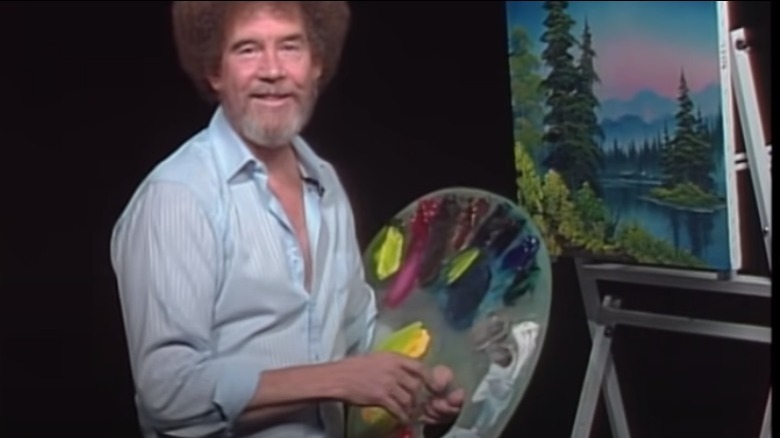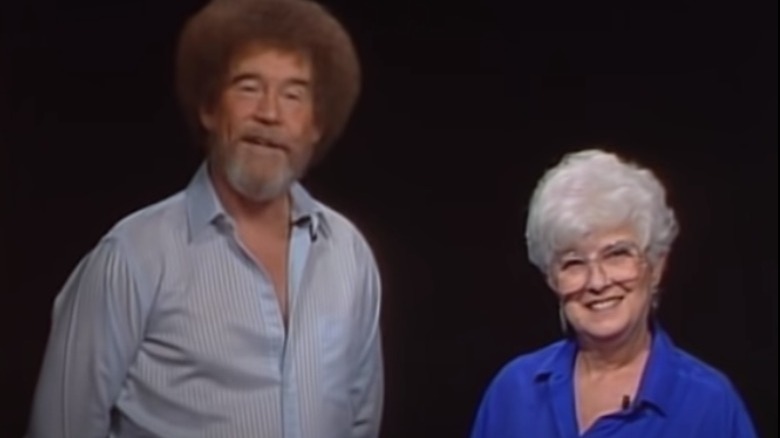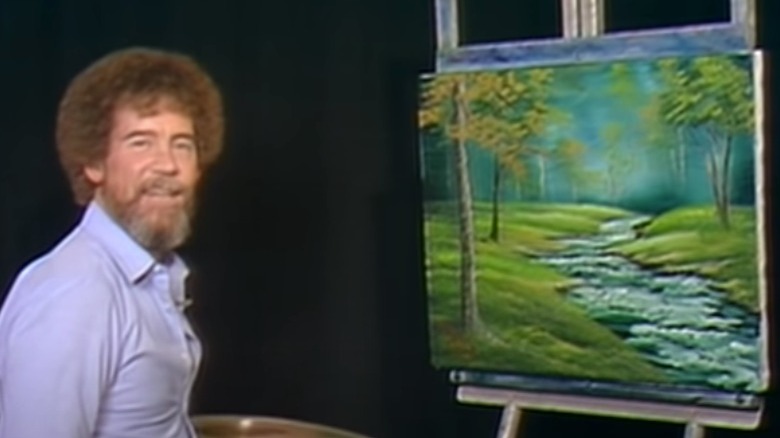Things We Learned After Watching Bob Ross: Happy Accidents, Betrayal & Greed
Contains spoilers for "Bob Ross: Happy Accidents, Betrayal & Greed"
Netflix's new documentary, "Bob Ross: Happy Accidents, Betrayal & Greed", is a portrayal of the complexities in the now-iconic landscape painter's life. Ross is best known for his PBS TV show, "The Joy of Painting," which ran for 11 years starting in 1983, per Britannica.
The film takes a look inside Ross's personal and professional life with his business partners Annette and Walt Kowalski, who are essentially vilified in the documentary. We also learn about his family relationships and remember his great success and popularity with his audience.
The story is largely told by Bob's son, Steve Ross, as well as a few friends and people who used to work with Bob. However, the Kowalskis chose not to participate in the film and, in an email, they threatened legal action if the documentary trod on them or their business, so we mostly get a one-sided story.
In the start of the documentary, Steve says he wants the "shameful" story of his father's legacy told, but it's not until the very end in which the audience gets a sense of what could be the real motivations for him coming forward after all these years — resentment, frustration, and possibly the fact that the Kowalskis are millionaires off of Ross's name and likeness — but Steve is not. After watching the documentary, it's hard to blame him.
Annette Kowalski thought Bob Ross was the bees knees
Steve Ross is certainly a sympathetic character and there is no doubt that he and his father had a loving and mutually respectful relationship. In the film we find out that Bob hoped that Steve and his epic mullet would follow in his own footsteps and take over his long-running show.
But what is really brought to the forefront of the film was the business relationship and the friendship between the Rosses and the Kowalskis. There is even an alleged — gasp — affair between Bob Ross and Annette Kowalski, both of whom were married to other people at the time, Bob to his long-time wife, Jane, and Annette to Walt. Steve alleged it. Annette denied it. Who knows? It's just another way the relationships between the Ross and the Kowalski families was complicated.
Regardless, the Kowalski's relationship with Bob Ross started with a tragedy. Per her own words in an old interview shown in the documentary, Annette Kowalski's son died and she was in a deep depression when she discovered Bob Ross, who was at the time traveling the nation doing painting workshops. When Annette met him via a live class, he changed her life.
His genuine infectious happiness and positive outlook helped pull her out of her grief. Annette said she once told Bob she doesn't know what it is that he has, but "Let's put it in a bottle and sell it." That foreshadowed what was to come.
Things were going well until Jane Ross died and Bob Ross got cancer
Everyone interviewed for "Bob Ross: Happy Accidents, Betrayal & Greed" all agree that Bob's positivity and charisma were genuine. They said he simply loved to paint and was a bit of a showman, so his role on "The Joy of Painting" was, well, a joy for him.
The Kowalskis and Jane Ross handled the business side of things — including a line of Bob Ross painting supplies — and Bob seemed happy with that set-up overall. While there were some points of contention over Walt wanting to sell a crappy product under Bob's name to make more profit, Bob wasn't having it and he got the last word on that with Jane's support.
For many years the two couples worked together, Jane and Walt and Bob and Annette. But when Jane died of cancer in 1992 things seemed to go downhill from there. Only weeks after her death, Bob learned he had lymphoma. He continued to work for a few more years, hosting "The Joy of Painting." Painting was his happy place and he threw himself into his work, the documentary reported.
In the meantime, as Steve and Bob's friends tell it, the Kowalskis were working hard to get Bob to sign over the rights to his name and likeness before he died. He refused and left 49% of the rights to Steve and 51% of the rights to his brother, Jim.
The Kowalskis went after everything when Bob was dying
Steve paints a grim story of his father's death, one that many people who have lost a loved one to cancer may recognize. He was emaciated, had lost his trademark hair, couldn't swallow, and was suffering greatly. Once Bob Ross finally died on July 4, 1995, the Kowalskis allegedly wanted his death kept under wraps because it was bad for business. They did not even attend their long-time friend and business partner's funeral. During the tug-of-war over the rights to Bob's name and likeness, his brother Jim quietly settled with the Kowalskis and signed over those rights, leaving Steve out in the cold.
Because the Kowalskis did not want to be part of the documentary, the film overall painted them as greedy backstabbers. Yet for many years they did run the business aspect of the company, so one can imagine they did not want to lose their comfortable livelihoods and they went all in. They allegedly went after all of Bob's paintings, his easels, anything that could be profited from. The deal was sealed in 2019 when Steve lost a lawsuit against the Kowalskis and Bob Ross Inc.
Bob Ross is possibly more popular than ever
Today, Steve does not profit from Bob Ross Inc., which makes an annual revenue of $1.5 million off myriad items with Bob's likeness along with branded art supplies, according to Dun & Bradstreet.
But The Wealth Advisor reported that the fact that Bob Ross has become a popular social media icon has helped plump up Steve's art classes, since people want to learn from the son of the man who said things like, "The secret to doing anything is believing that you can do it. Anything that you believe you can do strong enough, you can do. Anything. As long as you believe," (via Huffpost).
As much as Steve feels the Kowalskis took from him, the reality is that their business acumen might be the reason we are still talking about Bob Ross today, and maybe because it all ended up in their hands that Bob's messages of positivity are still garnering the attention of the world, especially on social media.
Bob still brings happiness to his fans, some of whom were not even born when he was alive. His words and voice are still soothing, his paintings are still beautiful and awesome to watch him produce so quickly, and whatever that magic is that Bob had — that thing Annette wanted to bottle and sell — it's still something people seem to gravitate to, 26 years after Bob Ross's death.
